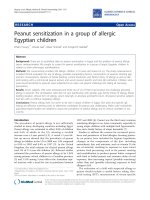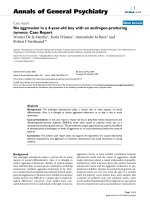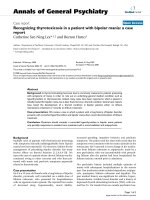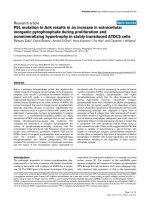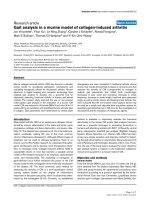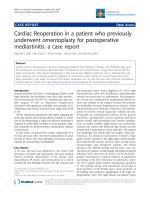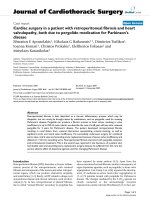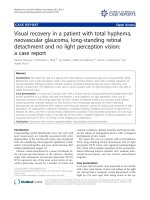Báo cáo y học: "Novel mutation in YMDD motif and direct neighbourhood in a child with chronic HBV-infection and clinical lamivudine and adefovir resistance - a scholarly case" docx
Bạn đang xem bản rút gọn của tài liệu. Xem và tải ngay bản đầy đủ của tài liệu tại đây (433.54 KB, 6 trang )
Schildgen et al. Virology Journal 2010, 7:167
/>Open Access
CASE REPORT
© 2010 Schildgen et al; licensee BioMed Central Ltd. This is an Open Access article distributed under the terms of the Creative Commons
Attribution License ( which permits unrestricted use, distribution, and reproduction in
any medium, provided the original work is properly cited.
Case Report
Novel mutation in YMDD motif and direct
neighbourhood in a child with chronic
HBV-infection and clinical lamivudine and adefovir
resistance - a scholarly case
Verena Schildgen
1,4
, Susanne Ziegler
2,3
, Ramona L Tillmann
4
and Oliver Schildgen*
2,3
Abstract
Context: Chronic HBV infection is a major cause of hepatocellular carcinoma (HCC) which meanwhile has become the
5
th
most reason for a fatal outcome of cancer. Worldwide, approximately 350 million people are chronically HBV
infected and as such of risk to develop HCC, of those an estimated high rate of children. Treatment of chronic infection
is sufficient to reduce the rate of HCC but the rate of sustained virological response remains to low, not at least due to
emergence of resistant virus strains. Less is known on HBV infection in children despite the extremely high rate of
chronicity.
Objective, Design, Setting, and Patient: The case of a nine years old male with a 6 year history of chronic HBV
infection, of those 5 years with antiviral treatment is described.
Interventions and Main Outcome Measure(s): Before our lab was consulted, the patient was unsuccessfully treated
with interferon, an obscure drug named Hepon, which should activate antiviral immune response, and Lamivudine,
the latter most likely becoming ineffective due to the mergence of resistant subpopulations (rtL180 M, rtV207 M, two
strains with stop codons at position rt188 and rt198, rtM204V (YVDD), rtM204K (YKDD)). Replacement of Lamivudine
by adefovir displayed no advantage despite the lack of resistance mutations, thus no decrease in viremia was observed
under adefovir treatment.
Results and Conclusions: Novel mutations in the YMDD motif and its direct neighbourhood were observed, both
being compatible with Lamivudine resistance. No mutations were found that are associated with ADF resistance. Both,
the clinical course of treatment and the genotypic resistance profile emphasize the need for systematic analyses of the
HBV resistance mechanisms and structured therapy concept also for children chronically infected with HBV.
Introduction
Hepatitis B virus (HBV), discovered in 1966, is one of the
major serious and global public health problems affecting
approximately 2 billion people worldwide http://
www.who.org. Estimated 350 million persons are chroni-
cally infected with HBV. Approximately 15-40% of
infected patients will develop cirrhosis, liver failure or
hepatocellular carcinoma (HCC) [1]. HCC incidence has
increased worldwide to the 5
th
most frequent cancer kill-
ing 300,000 - 500,000 people each year.
The estimated worldwide mortality caused by HBV
infection is 0.5-1.2 million deaths per year, although safe
and effective vaccines against HBV infections have been
available since 1982 [2]. Furthermore, the approval of oral
antiviral agents has revolutionised HBV treatment since
1998, and enabled effective clinical management of the
disease. Acute hepatitis B in adults is self-limiting in most
cases (95% of adults), therefore antiviral therapy is indi-
cated only for patients with protracted severe acute hepa-
titis or fulminant hepatitis [3,4]. Although this scheme
should be applied also for pediatric patient cohorts less is
known on the treatment of chronically HBV infected
children. Also in those patients two major strategies are
* Correspondence:
2
Institute for Virology, University Hospital Essen, Essen, Germany
Full list of author information is available at the end of the article
Schildgen et al. Virology Journal 2010, 7:167
/>Page 2 of 6
believed to have potential to treat chronic HBV infection
in adults, namely direct interference with viral replication
and modulation of the host's immune responses, the lat-
ter known to be immature in pediatric patients and thus
resulting in high chronicity rates.
The lack of knowledge in this cohort may be a result of
lacking clinical studies, the lack of drugs approved for the
treatment of chronically HBV infected children, and the
fact that the majority of chronically HBV infected chil-
dren comes from poor countries never having access to
antiviral therapy. Here we report the case of a young male
patient suffering from chronic HBV who after non-
response to interferon and initial treatment with lamivu-
dine developed resistance associated with YVDD and a
novel mutation in the YMDD motif. Furthermore, the
patient showed initial non-response to adefovir despite
the lack of resistance mutations, giving raise to the
hypothesis that host factors influenced this treatment
failure.
Case Report/Clinical Data
A male patient adopted from Cameroon, 4-year-old at the
beginning of the therapy history, was chronically infected
with Hepatitis B virus infection perinatally, as assumed
from anamnestic investigations. Chronic Hepatitis B
virus infection was diagnosed at the age of 3. Written
informed consent for publication of the clinical course
was obtained by the legal representatives of the patient.
First, he had undergone unsuccessful therapy with
Intron
®
A (recombinant interferon alpha-2b, 3 × injec-
tions per week) for nine month, leading to severe side
effects, including fever, insomnia with disorientation and
ostealgia. Within the first seven month of IFN-treatment,
the level of viremia increased from 4.0 × 10
7
molecules of
HBV DNA per milliliter to 8.4 × 10
8
molecules of HBV
DNA per milliliter (figure 1). Interferon therapy was
replaced by Hepon application (2 × daily sublingual appli-
cations). Hepon is suspected to be an immunmodulator
with antiviral activity [5], but clinical data and studies are
missing and the drug is not approved. The level of vire-
mia did not change significantly upon Hepon treatment.
Replacement of Hepon with lamivudine (Zeffix
®
100 mg
per day) resulted in HBV DNA levels below the detection
limit of the PCR assay -about 170 molecules of HBV DNA
per milliliter, within 12 month. However, the level of
transaminases (GOT, GPT) increased drastically (figure
2a). Lamivudine therapy was continued, with a dose
adjustment to 40 mg per day and transaminase levels
decreased to normal level. After three years of lamivu-
dine treatment resistance developed and the viremia
increased again to up to 1.3 × 10
8
HBV DNA molecules
per mL accompanied by slightly increased GOT levels.
This increase of viremia was suspected to be a clinical
and virological resistance to lamivudine which could be
confirmed by the existence of remaining viral subpopula-
tions with lamivudine resistance mutations (YVDD) (see
below). Therapy was switched to adefovir dipivoxil (Hep-
sera
®
5 mg per day), which did not respond sufficient and
viremia increased further to 7.94 × 10
6
molecules per mL.
Throughout the entire observation period, the patient
was positive for hepatitis B surface antigen (HBsAg) and
had antibodies against hepatitis Bc antigen (anti-HBcAg).
Because lymphocytes are essential inflammation mark-
ers in viral infections, the level of neutrophils and lym-
phocytes were analyzed throughout the observation
period as depicted in figure 2b. The percentage of lym-
phocytes throughout the observation correlates with the
level of HBV DNA. During the first 2 years of treatment,
only small fluctuations (65-75%) were observed in the
amount of lymphocytes. Replacement of Hepon with
lamivudine resulted in a decrease in lymphocyte level
from 70.9% lymphocytes to 50.2% lymphocytes and, after
an intermittent elevation to 62.9% lymphocytes, to 20.8%
lymphocytes. When resistance developed, the lympho-
cyte amount increased again up to 50% lymphocytes. The
reference value for the percentage of lymphocytes from
total blood cell count lies in a range of 25-40%. The per-
centage of neutrophils behaved converse to the amount of
lymphocytes. During the first 2 years of treatment, only
small fluctuations (~20% neutrophils) were observed in
amount of lymphocytes. Replacement of Hepon with
lamivudine resulted in an increased level of neutrophils
from 20% neutrophils to 44% neutrophils and, after an
interceptive decrease to 31.2% neutrophils, to 64.3% neu-
trophils. When lamivudine resistance developed, the per-
centage of neutrophils decreased again to ~35%. The
reference value for the percentage of lymphocytes from
total blood cell count lies in a range from 47-72%.
Throughout the observation period, the patient had
elevated levels of transaminases (reference value <23U/
L). The levels of transaminases during the treatment of
CHB with interferon, hepon, lamivudine and adefovir
didivoxil are depicted. After application of hepon, GOT
increases from 32-57U/L and GPT from 42-128U/L,
which significantly decreases again after application of
lamivudine to 40U/L GPT and 45U/L GOT. GPT level
drastically increase to 222U/L after eight months of lami-
vudine therapy, which again decreased to 33U/L after
adjustment of dosage. Replacement of lamivudine with
adefovir dipivoxil again resulted in a slight decrease in
both enzymes.
Gentotypic Analyses
For quasispecies analysis, HBV DNA was isolated from
patients' serum after failure of adefovir dipivoxil treat-
ment (06/2007) and parts of the polymerase gene of HBV
were amplified and cloned into pCR
®
4-TOPO
®
vector as
previously described [6,7]. A total number of 34 clones
Schildgen et al. Virology Journal 2010, 7:167
/>Page 3 of 6
were sequenced from both termini and in silico translated
into their amino acid sequences (figure 3).
The patient had virus variants containing a mutation
resulting in a substitution of leucine to methionine at
position rt180, as well as valine to methionine at position
rt207. In addition, the patient had a virus variant contain-
ing mutations that result in a stop codon (at position
rt188 and rt198). The analyses revealed that, beside the
above mentioned mutations, also virus variants with
mutations in the YMDD motif, namely a substitution of
methionine to valine (YVDD) and methionine to lysine
(YKDD) at position rt204 were present in patients'
serum, which is compatible with lamivudine resistance.
Especially this latter mutation rtM204K and the mutation
in the direct neighbourhood of the so called YMDD
motif, the rtV207 M exchange, may be considered as
novel mutations. No further mutations previously associ-
ated to antiviral resistance have been detected.
Discussion and Conclusions
A young male chronically infected with HBV failed sev-
eral therapy approaches, including INF-α and NRTIs.
Quasispecies analyses revealed and proofed the presence
of several mutations, including the rtM204V substitution,
which is well known to be associated with the selection of
lamivudine-resistance virus variants [8-11]. In addition to
the known rtM204V substitution, a novel virus variant
with a methionine to lysine (YKDD) substitution was
found. To the very best of our knowledge this mutation
was previously not reported and might also be associated
with lamivudine resistance.
Induction of isoleucine or valine in the YMDD motif
results in a sterical hindrance, preventing lamivudine
from appropriately configuring into the nucleotide bind-
ing site of the reverse transcriptase [12], and so the
rtM204K substitution may also do. The substitution of
lysine to methionine at position rt180 is also connected
and approved to contribute to lamivudine resistance and
is known to augments the lamivudine resistant in con-
junction with rtM204V [11]. Resistance-associated muta-
tions outside the YMDD motiv include amino acid
exchanges at the reverse transcriptase codon L180 M
(rtL180M) or the rtV207I codon [13]. In this latter report,
a novel valine to methionine substitution was present at
the above mentioned position rt207. Furthermore, at
position rt188 and rt198 nonsense mutations were identi-
fied in two clones, which can yield a truncated abbrevi-
ated protein often associated with loss of function. As a
Figure 1 Level of viremia in a patient receiving Interferon, Hepon, Lamivudine and Adefovir. The levels of viremia were measured by PCR-
based amplification. The limit of detection of each assay is 0.17 × 10
3
copies per mL.
Schildgen et al. Virology Journal 2010, 7:167
/>Page 4 of 6
Figure 2 a. Level of neutrophiles and lymphocytes during CHB treatment with interferon, hepon, lamivudine and adefovir dipivoxil. b. Lev-
el of the transaminases GOT and GPT during CHB patient receiving interferon, hepon, lamivudine and adefovir dipivoxil.
2a
2b
Schildgen et al. Virology Journal 2010, 7:167
/>Page 5 of 6
matter of speculation, such a truncated form of the pro-
tein could still be able to bind nucleos(t)ides and their
analogues that in turn are not available anymore in a con-
centration necessary to efficiently suppress viral replica-
tion, which besides host factors may have led to the
subsequent failure of ADF therapy. Furthermore it cannot
be excluded that viral genomes with stop codon muta-
tions may be packaged into Dane particles in liver cells
coinfected with wildtype or other viral strains. Surpris-
ingly, despite the well known fact that HBV forms qua-
sispecies, the concept of double infections or even
multiinfections of a single liver cell is only rarely taken
into account in the analyses of HBV quasispecies. Conse-
quently we assume that the mutations at position rt188
and rt198 may be not artefacts but true mutations,
although this hypothesis needs to be tested in further
studies.
The selection pressure caused by adefovir can lead to
upraise of the mutations rtA181V and rtN236T [14] or
rtI233V [6]. None of those substitutions were found in
the quasispecies analysis of the patient described. How-
ever, as a moderate response to adefovir was observed
due to the 2 log drop in viremia the patient's compliance
was good and does not explain the stagnation at the high
level of viral load.
This might be indicative for further mutations outside
the polymerase gene that have not been identified so far.
Other options for adefovir treatment failure might be that
either the applied prodrugs are not efficiently processed
into the active metabolites, or that the drugs are not effi-
Figure 3 Alignment of quasispecies analysis. Sequence of amino acids 157 - 237 in the reverse transcriptase domain of HBV polymerase is shown.
The mutations that are associated with lamivudine restistance are at position rt204. The mutations that resulted in a stop codon are highlighted in
yellow. A further mutation is located at position rtL180 M The HBV polymerase was amplified from patient material and cloned into TOPO vector,
which was transformed into E. coli. After purification of plasmid DNA, parts of the pol gene were sequenced as described above. Alignment was done
using Vector NTi software.
Schildgen et al. Virology Journal 2010, 7:167
/>Page 6 of 6
ciently delivered to the infected cell by a defective or
altered transport mechanism.
Here, as mutations conferring to ADF resistance are
missing, it can only be speculated whether mutations in
the periphery or a host resistance have contributed to the
clinical ADF resistance.
Nevertheless, the case is scholarly for a couple of
aspects: On the one hand it shows that there is a definite
need for HBV-therapy also in paediatric patients. Guide-
lines for the treatment of paediatric patients are missing
or leaky and clinical studies are rare or completely miss-
ing. Chronic HBV infections are rare in fully industrial-
ized countries with more or less intact health care
systems but are frequent in countries with emerging mar-
kets or in the developing world. In the view of the fact
that chronicity of HBV mainly develops if the infection
was acquired in the early childhood it must become a
major aim to sufficiently treat children that became
infected with HBV in order to avoid or reduce chronicity.
Thus, consequent and systematic studies for the treat-
ment of children are required.
Furthermore, as shown here by quasispecies analyses,
the clinical case presented here is a timely reminder that
HBV therapy is not a black and white picture but a highly
complicated challenge requiring systematic diagnostic
procedures and sophisticated interpretation of results in
order to apply the most effective medication schemes.
Finally, the case shows that more educational advertis-
ing is required in order to avoid dramatic treatment fail-
ures with obscure drugs that may help to give parents
some hope that their children could be cured but may
lead to severe desperation.
Competing interests
The authors declare that they have no competing interests.
Authors' contributions
VS performed the bioinformatical work, analyzed the clinical data, performed
parts of the cloning and analyzed the sequencing data. SZ established and
performed PCRs and was involved in sequencing. RLT was involved in cloning
and sequencing. OS supervised the study, designed the experiments and
wrote the manuscript. All authors read and approved the final manuscript.
Acknowledgements
This work was supported by a grant from the German Ministry for Education
and Research (BMBF) and was part of the HOPE-Project.
Author Details
1
Institute for Virology, Helmholtz Zentrum Munich, Munich, Germany,
2
Institute for Virology, University Hospital Essen, Essen, Germany,
3
Institute for
Virology, University Hospital Bonn, Bonn, Germany and
4
Institut für Pathologie,
Kliniken der Stadt Köln gGmbH/University Hospital Witten-Herdecke, Cologne,
Germany
References
1. Lok AS, Zoulim F, Locarnini S, et al.: Monitoring drug resistance in chronic
hepatitis B virus (HBV)-infected patients during lamivudine therapy:
evaluation of performance of INNO-LiPA HBV DR assay. J Clin Microbiol
2002, 40:3729-34.
2. Lavanchy D: Hepatitis B virus epidemiology, disease burden, treatment,
and current and emerging prevention and control measures. J Viral
Hepat 2004, 11:97-107.
3. Lok AS, Zoulim F, Locarnini S, et al.: Antiviral drug-resistant HBV:
standardization of nomenclature and assays and recommendations for
management. Hepatology 2007, 46:254-65.
4. Hoofnagle JH, Doo E, Liang TJ, Fleischer R, Lok AS: Management of
hepatitis B: summary of a clinical research workshop. Hepatology 2007,
45:1056-75.
5. Ataullakhanov RIHRD, Katlinskiĭ AV, Deriabin PG, Narovlianskiĭ AN,
Mezentseva MV, Ershov FI: An immunomodulator Hepon inhibits
hepatitis C virus replication in human cell cultures in vitro. Antibiot
Khimioter 2002, 47:9-11.
6. Schildgen O, Sirma H, Funk A, et al.: Variant of hepatitis B virus with
primary resistance to adefovir. N Engl J Med 2006, 354:1807-12.
7. Schildgen O, Schewe CK, Vogel M, et al.: Successful therapy of hepatitis B
with tenofovir in HIV-infected patients failing previous adefovir and
lamivudine treatment. Aids 2004, 18:2325-7.
8. Bartholomew MM, Jansen RW, Jeffers LJ, et al.: Hepatitis-B-virus
resistance to lamivudine given for recurrent infection after orthotopic
liver transplantation. Lancet 1997, 349:20-2.
9. Dienstag JL, Schiff ER, Wright TL, et al.: Lamivudine as initial treatment for
chronic hepatitis B in the United States. N Engl J Med 1999, 341:1256-63.
10. Dienstag JL, Schiff ER, Mitchell M, et al.: Extended lamivudine
retreatment for chronic hepatitis B: maintenance of viral suppression
after discontinuation of therapy. Hepatology 1999, 30:1082-7.
11. Allen MI, Deslauriers M, Andrews CW, et al.: Identification and
characterization of mutations in hepatitis B virus resistant to
lamivudine. Lamivudine Clinical Investigation Group. Hepatology 1998,
27:1670-7.
12. Doo E, Liang TJ: Molecular anatomy and pathophysiologic implications
of drug resistance in hepatitis B virus infection. Gastroenterology 2001,
120:1000-8.
13. Zollner B, Sterneck M, Wursthorn K, et al.: Prevalence, incidence, and
clinical relevance of the reverse transcriptase V207I mutation outside
the YMDD motif of the hepatitis B virus polymerase during lamivudine
therapy. J Clin Microbiol 2005, 43:2503-5.
14. Angus P, Vaughan R, Xiong S, et al.: Resistance to adefovir dipivoxil
therapy associated with the selection of a novel mutation in the HBV
polymerase. Gastroenterology 2003, 125:292-7.
doi: 10.1186/1743-422X-7-167
Cite this article as: Schildgen et al., Novel mutation in YMDD motif and
direct neighbourhood in a child with chronic HBV-infection and clinical lami-
vudine and adefovir resistance - a scholarly case Virology Journal 2010, 7:167
Received: 26 April 2010 Accepted: 21 July 2010
Published: 21 July 2010
This article is available from: 2010 Schildgen et al; licensee BioMed Central Ltd. This is an Open Access article distributed under the terms of the Creative Commons Attribution License ( ), which permits unrestricted use, distribution, and reproduction in any medium, provided the original work is properly cited.Virology Journal 2010, 7:167
